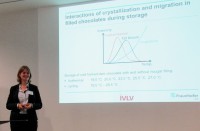Fraunhofer-Institut für Verfahrenstechnik und Verpackung IVV
Problem identified, problem solved
The variety of topics was diverse at the 53rd session of the chocolate technology study group at the IVLV in Freising/Germany. It ranged from the sustainable production of palm oil to the formation of bittern in hazelnuts and fat bloom in chocolate products.
By Dr Bernhard Reichenbach
Well attended with over 110 participants, the 53rd session of the chocolate technology study group at the IVLV (Industrievereinigung für Lebensmitteltechnologie und Verpackung e. V. [Industry Association for Food Technology and Packaging]) recently took place in Freising, near Munich, at the facilities of the cooperating Fraunhofer Institute for Process Engineering and Packaging (IVV). The two-day lecture event offered prime opportunity to network and gain information. The first day featured the topics of palm oil, hazelnuts, chocolates with whole nuts, as well as machines and systems, while the second day’s programme included the areas of fat bloom/crystallisation, flavour, and research planning.
In his lecture titled “Palm oil production chain in truly sustainable cultivation”, Stephen-Sven Hubbes, food technology and product developer at the company Rapunzel Naturkost, introduced two sustainable palm oil projects. Rapunzel is supplied with a total of 350 t of fair trade palm oil from around 850 organic farmers associated with these projects in Ghana and Ecuador. In Ghana, the palms are cultivated on formerly deforested, fallow tropical land. “This takes place in conjunction with legumes, in order to promote humus formation,” reported the lecturer. “For the same reason, the farmers bring the remnants of the palm fruit back to the palm farms after the palm oil has been pressed in the oil mill. This makes the use of artificial fertilisers unnecessary.”
Food biologist Dominic Bahmann of the University of Hamburg – BioCentre Klein Flottbek illuminated aspects of hazelnut production in Turkey and possible factors that influence the formation of bittern. He showed that between 1 and 3 % of stored hazelnuts have a strong bitter taste, which can lead to significant financial losses for producers. It was discovered that the bitter taste is due to a substance called asadanin, which also occurs in hazelnut leaves. Its concentration in hazelnuts increases as a result of feeding damage by a certain bug, which has been spreading from England. Another considerable cause for strong increases in asadanin concentrations is the germination of the hazelnuts.
New study group initiates 29 new projects
Dr Gottfried Ziegleder and Isabell Rothkopf from Fraunhofer IVV held lectures on the problem of fat bloom formation on chocolate products. Ms Rothkopf elaborates in detail on the object of research in a specific contribution piece.
As part of the event, Dr Peter Golz from the VDMA (Mechanical Engineering Industry Association) introduced the new IVLV study group for confectionery machines, which was founded in autumn 2016 and includes 165 companies as well as 21 research sites. It emerged from the confectionery machines study group, which resulted in a new orientation towards collaboration at the pre-competitive stage.
Currently, there are 29 projects with a total volume of € 10.8 m. The study group operates as a steering committee, which is made up of roughly equal representatives from the machine engineering (manufacturers) and the confectionery industry (users). The committee initiated and conducted selected research projects. The first selected issues included dry cleaning and the detection of fracture formation on chocolate moulds. •
http://www.ivlv.org http://www.ivv.fraunhofer.de



